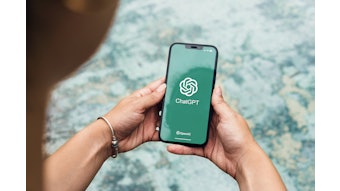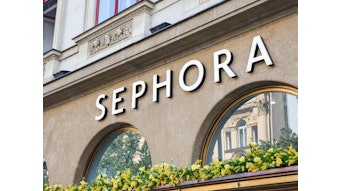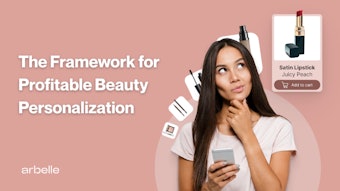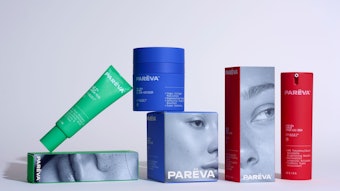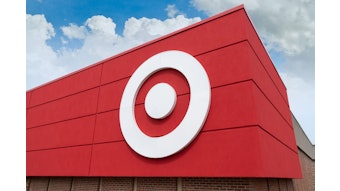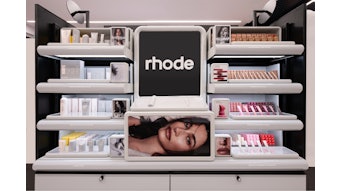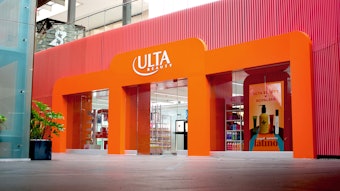- Regardless of where or how the final purchase is made, consumers often start their research and browsing online, and when they find the product, they want to purchase it wherever they may be at the time.
- When a brand does not have wide distribution, it’s important to have a strong and informative online presence, but brick-and-mortar retailers still help impart a positive emotion that can only come from person-to-person contact.
- The most important frontier for brand owners today is highly fragmented digital media spaces and their transformative effect on consumer brand experiences.
For beauty brands, consumer loyalty has become a bit elusive. Brands need to ensure that they are meeting—or exceeding—expectations so that consumers continue to see the enhanced value brands deliver. And that “value” must extend beyond the product purchase. “Brands that connect with consumers throughout the research, purchase and use continuum can help guide customers to the best products for them, ensure that they know the best ways to use the products, and gain powerful feedback to continue to evolve their products to meet the evolving needs of their consumers,” said Kelly O’Neill, director of product marketing, ATG—a provider of personalized cross-channel commerce software and services. Brands that are good at doing this will deliver value well beyond product prices.
Consumers have fundamentally changed the way they live and shop. “We are quickly becoming a digital-centric world as consumers turn toward their laptops and cell phones to find information, connect with their friends and family, and access goods and services,” said O’Neill. In fact, a recent ATG survey shows that 48% of consumers typically use two channels—computers, mobile devices, brick-and-mortar stores, catalogs, customer service reps, etc.—to browse and research products, whereas another 24% say they use three channels.
Regardless of where or how the final purchase is made, consumers often start their research and browsing online. They turn to brand sites, social sites, bloggers and retailers to learn about new trends and products. And, when they find the must-have product, they want to buy the product wherever they may be at the time. Brands that offer consumers multiple paths to purchase—through their traditional retail partners, through new affiliates and partnerships, and directly through their own or distributor Web sites—will best meet the needs of this new “commerce anywhere” consumer.
Mass Retail
German-based Lavera Naturkosmetik used the downturn in the economy to make its products available to a wider audience. Lavera is among the market leaders in Europe for natural skin care with 27% of market share in general health and beauty products and a 50% market share in sunscreen products. But the brand has its sights set on the American mass market. Best-sellers from Lavera skin care, makeup, hair care and sunscreen lines were launched through California CVS/pharmacy locations and cvs.com in 2009 and launched in Target stores nationwide in March 2010. The calendula-infused products are now available in 24,000 doors in 25 countries.“It is our goal at Lavera to make truly natural skin care and beauty products more accessible to customers,” said Ulrike Jacob, CEO, Lavera USA. “By exposing more consumers to natural products, Lavera expands on its goal of promoting health, radiant skin and overall well-being.”
Although the brand uses the Internet to educate consumers about the brand, 90% of sales are from brick-and-mortar retail. By piggy-backing on Target’s credibility in a slow economy, the brand has been able to weather the economic storm. In fact, throughout the recessed economy, Lavara was able to expand by 1,500 doors by refocusing on its message: Green You Can Believe In!
Not deviating from its multichannel marketing and retail strategy was key as well. “We’ve managed our image and positioning in today’s increasingly digital marketplace very well,” said Jacob. Positioning itself as an affordable natural line, the brand’s philosophy aligns with today’s mass market shoppers. “The biggest success for retailing our brand in today’s beauty industry is staying true to our ingredient commitment,” said Jacob.
The brand adopted the strict guidelines set by BDIH, the regulatory organization in Germany, a stringent certification process for ensuring products are manufactured to the highest standards of being all natural and ecologically friendly. Lavera committed itself to providing greater transparency to consumers about products. It’s a message that’s certainly not gone unnoticed.
Specialized Retail
Blinc benefited from a long-term retail strategy of growing through small, independent, high-end spas, salons and beauty supply stores. With nearly 10,000 doors throughout the U.S., as well as international distributors, the brand was able to sustain a solid retailer base through the tough economy and minimize risk.
The brand initially tried mass channels in Canada upon its launch of its Kiss Me Mascara product 11 years ago. But consumers misinterpreted the brand and product message, and it was quickly realized that education needed to go along with the product. So, one at a time, the company partnered with salons and spas in the U.S. where trained professionals could provide a little needed explanation. The company now goes to 40 trade shows a year to expand its retail partners. Outside the U.S., the brand primarily has bulk distributor sales in the U.K., Australia, Canada, Sweden and the Netherlands, strictly being reactive to requests. In 2009, however, the brand went to Cosmoprof Bologna, and is being more proactive in seeking the right partners to help replicate its success in the U.S. Deals in the making could open exploding Asian markets, and help mitigate any potential stagnation in the U.S. market.
The brand is also marketed to relevant channels outside strictly salon/spa. “We look at each of our products one at a time and determine who it is relevant to,” said Lewis Farsedakis, CEO, Blinc Inc. The mascara, for example, is a practical product for athletes and brides, so the brand started showing up at yoga, running and bridal shows. In addition, the company is about to launch a national campaign called Rethink Your Wink to emphasize the product’s performance. It will feature active consumers boasting about their mascara that “allows you to live the way you want to.” The company will be buying media for fall 2010, saturating one market for a month or two through local television, magazines, print, radio and direct mail before moving on to another market and repeating the process across the U.S.
The professional channel limits the brand from some types of growth. If the products were to become available in mass retail stores, it believes it would lose credibility with its core customers—who would potentially drop the brand. By keeping diversification within 10,000 stores it sold to directly, though, the company didn’t feel the effects of the economy as others may have and feel secure in its decision.
“We’ve had nearly 11 years of consecutive growth,” said Farsedakis. As one of Inc. 5000 fastest-growing private companies in 2007, 2008 and 2009, even the financial industry recognizes the brand’s significant double-digit growth.
Amid a full-blown recession, the Boca Raton, Florida, entrepreneur sought ways to streamline his already-lean cosmetics business. The strategies left Blinc more agile and profitable, even in a down economy. “We already run a tight business, but we had to get creative and proactive to get through rough waters,” said Farsedakis. “Flat was pretty good for the rest of what the country was doing. The changes we made put us up 90% in profits (up 150% through the first quarter of 2010), even though sales were up only single digits. The Blinc brand is more profitable now than it has ever been.”
Among the changes, Farsedakis encouraged retailers to stock up, in volume and variety. While his competitors kept their minimum orders the same, Farsedakis halved his minimum order to $125. He also allowed retailers to pick whatever products and quantities they needed, as opposed to pushing pre-packaged orders. “We have to be in tune with our retailers’ needs. If that means them buying ones and twos of product, that’s what we’ll do,” he said. In order to pick and pack whatever customers want, in whatever fashion they want, however, the company had to do its own fulfillment. “You cannot make real-time adjustment with a service, so we quickly brought it in-house. We were already positioned to accommodate a bad recession, and our customers never really dropped off.”
The company also did as much as possible to ensure its retail partners could make money on its products with spending as little as possible. To help, the company created a booklet on 22 ways for businesses to make money with its products. Farsedakis emphasized the importance of marketing, especially when hurting. “Even though you don’t want to, stick your feet deeper in, and you will emerge much better with stronger partnerships,” he said. What he did was provide new displays to carry not just flagship products but all product and colors, and created programs for the retailers to use, with the brand paying for marketing materials and even food for special events within the retail environment. All the retailers had to do was pay postage to mail invitations to their customers. “We got the people to come in the store, gave them something free and exposed them to our product,” said Farsedakis. “It pays for us to do that. Everybody wins.”
“You have to have the confidence in your brand to know where you are and know you’re building something more important for the future,” he continued. “Instead of sitting, waiting and hoping, we were building and planting the seeds to make 2010 a terrific year.”
Where competitors were cutting back, Blinc was also launching new products. Having introduced the concept of tube mascara 11 years ago, Blinc has slowly but steadily expanded its offerings within the eye category. “We are not about being everything to everyone,” explained Farsedakis. “We want Blinc to be a serious brand, so we keep building on what we know, innovating new products based on unique product performance.” With six months required to get product and marketing collateral to market, aggressive new product debuts set the stage for recovery. By investing in developing more technologies, the brand is positioned to roll out new products when the economy is back in a growth period. “We’re not hostages of our own business plan,” said Farsedakis. “We’re on an innovation calendar, not a marketing calendar. When a product is ready, we launch it. When the economy comes back, we’re already selling.”
Although 75% of Blinc sales are from retailers, products are available online. Because the brand is not readily available everywhere, it’s important to have a medium available to consumers. Blinc has an increasing presence online and sales are growing. But the most popular page of the Web site is “Find a retailer near you.”
“People will always like the experience of playing with and touching the makeup and talking with people,” said Farsedakis. “I don’t think that can be replaced. It’s an experience.” Regardless of whether a product needs education, retailers can help impart a positive emotion that can only come from person-to-person in the store.
Online Retail
Retailing has changed quite a bit because of the growth of the Internet. Many traditional brick-and-mortar stores and catalogs have expanded to an online presence, and certain products are easier to sell online than others.
“The advantages of the Internet to the beauty industry are enormous,” said Leslie Linevsky, co-founder, Catalogs.com. The company currently represents more than 650 retail clients, and 19 merchants in the beauty and cosmetics category. “E-commerce selling of beauty and cosmetics is one of our very strongest categories because everything ‘fits.’ Especially when women—and now men, too—know the brands they want, it is so incredibly easy and convenient to shop online.” In addition, most beauty products are relatively lightweight, so shipping charges almost never impede the decision. Even though customers cannot test cosmetics online, brands that sell online can offer samples, trial sizes and free gifts, which is especially effective through social media. According to Linevsky, there are five main advantages of selling online instead of at a retail brick-n-mortar location.
Tied for first and second are unlimited selection and accessibility. “Shoppers have the opportunity to purchase anything their hearts desire, no matter how obscure or unique or how big or how small the products may be,” she explained. Third on the list is knowledge—the ability to read customer reviews and comments prior to purchase. “Social media—specifically blogs, Facebook and Twitter—allows brands to easily disseminate targeted messages about new product, or answers to customers’ honest—and often very specific—questions,” said Linevsky. A well-managed social media campaign directed and targeted to the beauty industry is certainly an advantage. Beauty products are perfect for referrals and recommendations and how-tos.
Incentives is fourth. For example, in its 14-year history, Catalogs.com has learned that more than 75% of merchants offer exclusive savings certificates to motivate and inspire a consumer to take immediate action, and, “It’s a strategy that works well, especially when a retailer rewards the consumer with free shipping if spending over a set amount of dollars,” said Linevsky. “This strategy not only accomplishes increasing the average amount each consumer spends, but also captures the data of a potential life-long repeating customer, which is worth a lot.”
The fifth advantage of selling online is convenience. “We all lead very fast-paced, crazy lives, filled with incredible restrictions on our time,” she explained. “Shopping online is not only convenient, but also time efficient and eco-friendly.” Linevsky emphasizes that print catalogs offer many of the same advantages as shopping online. “It is interesting that many shoppers will forgo a visit to a store if they have a print catalog to browse, and that those same shoppers then make their purchase online,” she said. This is one reason that a multichannel approach to beauty retailing is key.
Price competitiveness is the challenge of online sales. If a consumer simply wants to “replenish” or buy the latest spring colors within a favorite brand, it is very easy for her to “shop price.” This is the challenge for many online retailers. The good news is, many consumers also like to browse, and this is where the artistic design and creative copy comes into play for a Web site. Retail e-commerce sites must be ever-changing, clearly depicting product and selling “image.” The best sites provide entertainment as well as product, Linevsky emphasized.
Caswell-Massey is an example of a company that is consistently and carefully executing a multichannel branding strategy and leveraging its reputation. A longtime Catalogs.com client, the Newport, Rhode Island company was founded in 1752. The company’s main brand is its name, and even though there are brick-n-mortar stores, it is effectively using cross-channel venues to sell and promote its product and its reputation. The brand is true to its positioning as “America’s original purveyor of luxury personal care products and accessories.” Caswell-Massey’s Facebook page looks perfectly like Caswell-Massey’s Web site. “It is not edgy, but it is consistent,” said Linevsky. “And it gets tremendous fan interaction—a lot of comments.”
Philosophy has a very important place in marketing strategy. Especially with the Internet, where a consumer can search for a product with any number of caveats. Customers can search for specialty, or niche products can leverage a unique positioning online to target a specific market. Searches for “vegan cosmetics” or “cruelty-free cosmetics” or “test-free” allows users find a beauty outlet that aligns with their philosophies. By building marketing efforts around a commitment to a niche group, such brands are aligning their philosophies with particular market segments, and capitalizing upon it with intelligent search.
However, breaking into the Internet as a first-time online retailer today requires substantial capital.
Advertising, search engine optimization, computer programming and sales support are essential but expensive. Striking up a partnership with existing and established Internet stores and selling a brand through established sites is another option. “Competition is fierce for Web presence,” said Linevsky. “Partnerships continue to be powerful in leveraging visibility, and in offering shopping options to consumers.” She suggests starting by developing a product-focused blog, Facebook and Twitter accounts, and actively using them to promote, brand and sell if truly interested in building a successful Internet-based business venture.
Follow-through
After inventory costs and prime retail space disputes, the most important frontier for brand owners today is highly fragmented digital media spaces and their transformative effect on consumer brand experiences. Whether you sell online or not, customers are rapidly embracing social media for brand research and testimonials. Information, feedback, validation and opinions from trusted sources play an important role in branding, especially given consumers’ high involvement with the beauty category. A more creative and dynamic approach is required to follow the needs and wants of well-informed, increasingly discerning and omnipresent consumers. In addition to creating cohesive and effective brand positioning, cosmetic brands need to reach out to consumers wherever they can. People have very individual shopping preferences, and the brands that market through every channel will have a competitive advantage.
Brands can use e-commerce Web hosting services such as ATG—whose clients include Sephora, Yves Rocher, P&G and JCPenney—to cut costs by outsourcing technology and business processes. Such firms provide e-commerce and cross-channel commerce software services. Once relegated to small business initiatives only, today e-commerce as a service (also known as “e-commerce on demand”) can deliver the full functionality required to deliver a highly sophisticated e-commerce experience. At the same time, it holds the potential to lower entry costs, improve productivity, and increase ROI. E-commerce optimization services allow retailers to deliver a relevant and consistent customer experience—treating interactions over the Web, phone, chat, mobile devices, and even stores as one continuous, ongoing relationship, rather than disconnected conversations.
Good customer service is as important as ever. Even Internet companies cannot abandon the telephone. “We want to hear what our consumers and e-commerce merchants have to say about what is really working and what is not so we can provide the best service possible,” said ATG’s O’Neill. “We counsel our merchants to do the same—work to secure a customer and work twice as hard to keep them.” Brands are built with customer loyalty, the same as always.
Sara Mason is a freelance writer based in the Chicagoland area. She was previously managing editor of GCI magazine.
